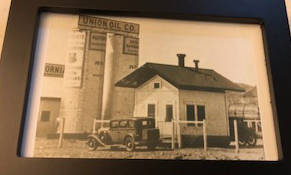
Ninety years ago this month, Boulder City was officially placed on the map.
Carole Gordon and members of her family marked the occasion by showcasing four buildings that were constructed adjacent to the Union Pacific railroad tracks to support the fledgling city.
Standing in the 1300 block of Boulder City Parkway, the structures, owned by Gordon, were built by the Union Oil Co. of Nevada and Standard Oil Co. of California to supply fuel for construction vehicles as well as the airport, which was across the street. Remaining on site are a houselike office and three warehouse structures.
“Boulder City was placed on the map February 1, when the Union Pacific System completed its 22.71 miles of branch line connecting with the main line south of Las Vegas, Nevada, … ,” wrote Joel L. Priest Jr. in the March 1931 issue of “The Union Pacific Magazine.”
The railroad line was considered a first step for the construction of Hoover Dam, as it provided a way for supplies and materials to be transported to the site.
Randy Hees, director of the Nevada State Railroad Museum, said the buildings were adjacent to a spur off the main railroad tracks.
“They are important as they supported the city,” he said.
Mark Hall-Patton, museum administrator for the Clark County Museum system, agreed, calling the four buildings some of the earliest structures built in Boulder City.
“They are historically significant to Boulder City.”
Hall-Patton said the community “can consider itself very lucky” because so many buildings from the 1930s remain standing.
While all of the buildings have been modified — two house Tom Devlin’s Monster Museum and one houses a store — the small office is the closest to original, Hall-Patton said.
According to Monsignor Gregory Gordon, Carole Gordon’s son, part of the original tin roof was damaged in a storm and had to be repaired but the interior beadboard ceiling and walls are original.
Carole Gordon said a small safe in the floor remains intact, and the bathroom door and door knob also are original.
Gregory Gordon said the four buildings are all that remain of the 15 built on the site.
“I like to say this marked the start of Boulder City,” he told a small group gathered to learn more about the buildings. “This is our history.”
Three historic buildings that once were in Boulder City, including the original Union Pacific depot and Grand Canyon Airlines ticketing office, are now at the county museum in Henderson.
Hees said that at one point there were seven sets of tracks behind the historic buildings and they were part of a transfer area. Three lines were owned by Union Pacific and four were owned by the government, he added.
In addition to describing the first buildings in town, the magazine article also detailed the 10-mile stretch of railroad tracks that will travel “around the mountain grades and through four tunnels leading to the top and bottom of the granite walls of Black Canyon which will harbor Hoover dam.”
Today, part of that stretch makes up the Historic Railroad Tunnel Trail in Lake Mead National Recreation Area. Hikers can pass through the tunnels as they walk along the former railroad grade that offers panoramic views of Lake Mead.
Hali Bernstein Saylor is editor of the Boulder City Review. She can be reached at hsaylor@bouldercityreview.com or at 702-586-9523. Follow @HalisComment on Twitter.